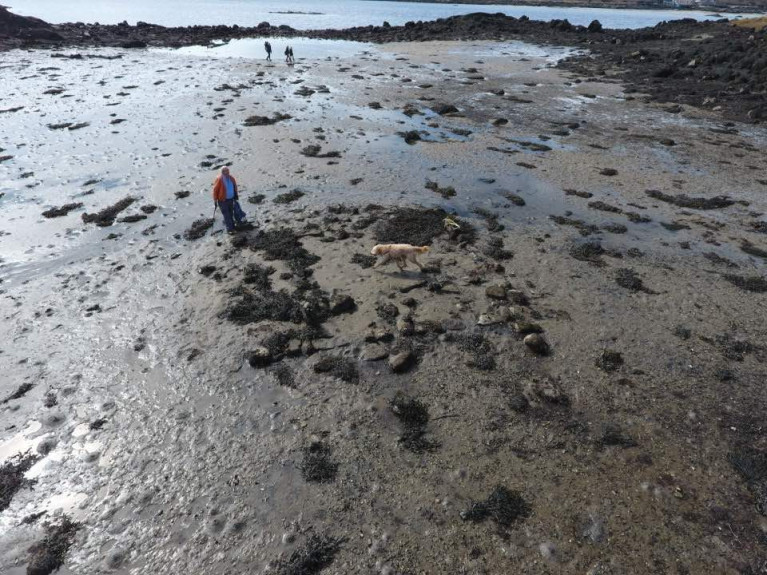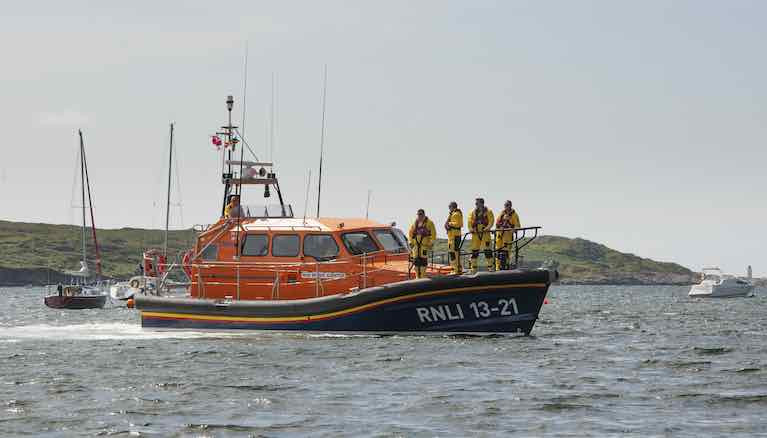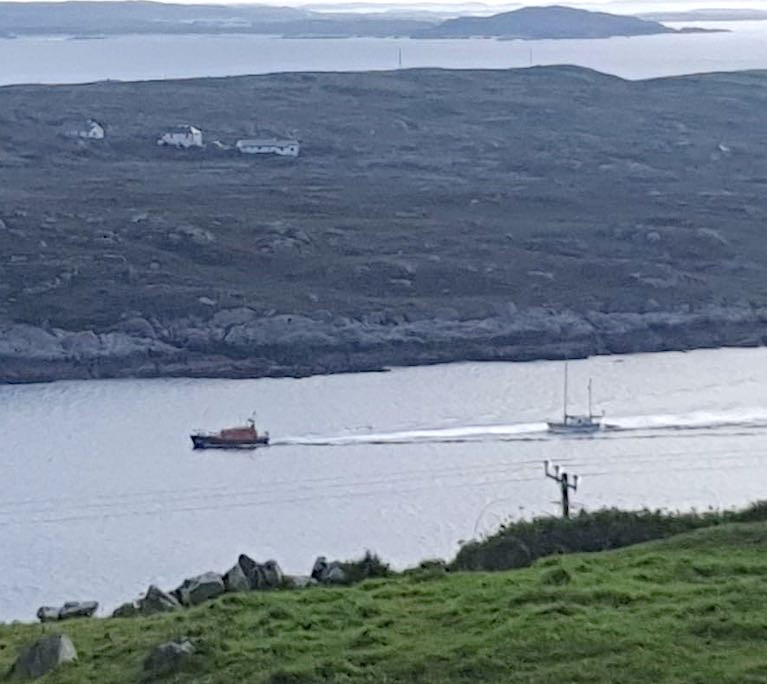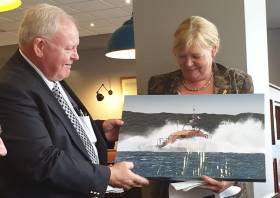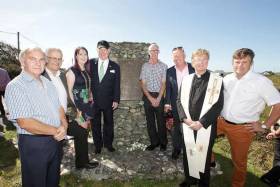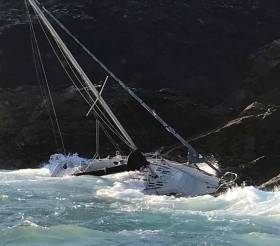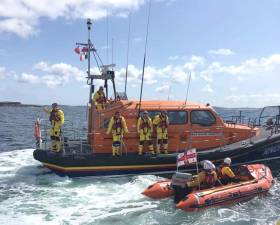Displaying items by tag: Clifden
Further Evidence of Sea Level Rise Along the Atlantic Coast Uncovered on North Connemara Inter-Tidal Zone
Discovery of the remains of a “drowned” prehistoric house in north Connemara may be further evidence of sea-level rise along the Atlantic coast in the last millennium.
As The Sunday Times reports today, parts of a small prehistoric dwelling covered by sea except at low spring tide have been identified by archaeologist Michael Gibbons and engineer Shane Joyce on the coast south-west of Clifden, Co Galway.
The site is in a sheltered “lagoon-like setting” on the tip of the Faul peninsula, at the junction of Clifden and Ardbear bays.
Gibbons said that the structure is similar in size to early Neolithic houses, and it is protected from tidal surges by Oileán Gearr or Islandagar, a small island on its western side.
Gibbons said it was further evidence of a “drowned prehistoric landscape”, which has been researched and dated by NUI Galway palaeoecologists Prof Michael O’Connell and Dr Karen Molloy.
O’Connell and Molloy have estimated that sea levels rose by as much as four metres on the Atlantic coast in later prehistory - as in 1,000 years ago – with Galway Bay being younger than originally estimated.
Prof O’Connell said that it was “quite reasonable” to suggest the structure identified by Gibbons and Joyce may be early Neolithic, given that sea level rise occurred in the late Neolithic period.
O’Connell and Molloy’s work focused on tree stumps, believed to be bog pine, which have been exposed at low tide by storms dating back to 2010, along with pollen analysis of coastal peat deposits.
Gibbons said that a shell midden dating from 4,000 BC on the Errislannan peninsula, just south-west of the Faul location, was also evidence of Neolithic settlement by early farmers.
Read The Sunday Times report here
Clifden RNLI Launch All-Weather Lifeboat to go to the Aid of Child with a Suspected Broken Leg on Inishbofin
Clifden RNLI’s all-weather lifeboat was tasked by the Coast Guard last weekend (Saturday 15 August) to assist with the medical evacuation of a 10-year old girl with a suspected broken leg, on Inishbofin. The calm conditions made for a gentle crossing by lifeboat and the girl was transferred into the care of HSE paramedics at Cleggan.
The lifeboat was tasked at 6.50pm and was underway to Inishbofin at 7.10pm with an expected journey time of 30 minutes. The district nurse on Inishbofin had requested assistance after the casualty was involved in a biking accident while exploring the island. Upon arrival at the pier in Inishbofin and once the lifeboat was securely tied alongside, the volunteer crew transferred the casualty onto the lifeboat stretcher.
Using their RNLI casualty care training they made the young girl comfortable and transferred her aboard the lifeboat, accompanied by her mother. They were brought to Cleggan pier where a HSE ambulance was waiting and the lifeboat crew handed the casualty into the care of the HSE paramedics. They then returned to station.
Weather conditions were good with a light northeast wind and a calm sea state.
Clifden RNLI Coxswain Alan Pryce said, ‘We were delighted to be able to assist with the casualty transfer and we all wish her a speedy recovery. The capabilities of the Shannon class lifeboat ensured a fast response by the crew and also made for a comfortable crossing to Cleggan for the girl and her mother.’
Clifden RNLI lifeboat crew for the callout were Coxswain Alan Pryce, Lifeboat Mechanic Joe Acton and volunteer crew Alvin Bell, Andy Bell, Chris Nee and Alan Kearney.
Clifden RNLI has rescued a sailor who got into difficulty on a 36ft yacht this afternoon. The volunteer lifeboat crew were requested to launch at 3.20 pm by the Irish Coast Guard following a report that a yacht was in difficulty somewhere between Cleggan and Inishbofin Island.
As communication with the casualty was poor initially, a decision was made to launch Clifden RNLI’s inshore lifeboat in addition to the station’s all-weather lifeboat.
Weather conditions at the time were fair with a Force 3 northerly wind and a slight sea.
The inshore lifeboat helmed by Daniel Whelan arrived on scene first, some 10 miles from Clifden. The lifeboat crew assessed the situation and checked that the one man onboard was safe and well. A crew member then transferred onto the yacht to set up a tow.
 The yacht under tow by Clifden RNLI
The yacht under tow by Clifden RNLI
On arrival of the all-weather lifeboat under Coxswain John Mullen, the tow was passed from the inshore lifeboat to the all-weather lifeboat. The all-weather lifeboat then towed the yacht safely back to shore with the Atlantic 85 lifeboat alongside.
Speaking following the call out, Clifden RNLI Coxswain John Mullen said: ‘We would like to commend the sailor for raising the alarm when he got into difficulty, that is always the right thing to do, and we would like to wish him a safe onward journey.
‘As the summer continues and we enjoy some good weather, we would remind everyone regardless of their activity at sea, to always respect the water. Always wear a lifejacket, always have a means for calling and signalling for help and ensure everyone onboard knows how to use it. Always check the weather forecast and tide times before heading out and make sure someone on the shore knows where you are going and when you are due back. Should you get into difficulty or see someone else in trouble, dial 999 or 112 and ask for the Coast Guard.’
Tributes Paid To Lifeboat Volunteers In Connemara
Members of the Connemara/Clifden RNLI Lifeboats Fundraising Branch gathered at the Station House Hotel in Clifden recently to acknowledge the contributions and retirements of some longstanding members.
Area fundraising manager Tony Hiney, who is himself set to retire this year, joined with Clifden RNLI fundraising manager AnnMarie Bennett and chairman Pearse Hyland to present the awards.
Geraldine Heanue of Letterfrack received an award in recognition of her retirement after more than 20 years service as a fundraising officer.
Stuart Freeman of Ballynahinch was presented with an award for long service on his retirement, having volunteered as an RNLI box collector and fundraiser for over 40 years.
A posthumous award was presented to Ann and Catherine Coyne in recognition of Clifden man Owen Coyne’s longstanding support of the lifeboats during Flag Day and church gate collections.
Margaret Wallace was also recognised for her volunteering for collections and retirement from the fundraising team.
Bernie Davis received an award for excellence in volunteering for her long-running annual participation in the Dublin Women’s Mini Marathon in support of Clifden RNLI.
Although unable to attend on the day, Michael Mullen also received an award for excellence in fundraising for his annual darts competition in memory of his son Mikey Mullen, who was tragically lost at sea.
Mikey’s mother Laurence Inglebach also received an award for excellence for her annual fundraising Clifden Lifeboat 10k Run earlier this year.
‘Without the time and energy of our fundraising volunteers, the crew would simply not be able to carry out the lifesaving work that they do’
Speaking at the gathering, AnnMarie Bennett thanked everyone in attendance for their consistent and long standing support of the lifeboats in Connemara.
“The Clifden RNLI has grown and developed hugely over the years and the generosity and dedication of all our fundraising volunteers is what helps this to happen,” she said.
“Without the time and energy of our fundraising volunteers, the crew would simply not be able to carry out the lifesaving work that they do, and we are all extremely grateful for everything you have done in support of the lifeboats.
“Your generosity and time has saved lives and helped families and our community in so many different ways over the years.”
33-Hour Survival in Liferaft at Sea After Wartime Air Crash Remembered in North Connemara
An epic rescue of five north American naval crew who survived 33 hours in a liferaft has been marked on the 75th anniversary of the incident in north Connemara writes Lorna Siggins.
Five of their fellow crew died when a US PB4Y-1 Liberator bomber aircraft - en route from Virginia, USA, to Iceland - crashed into the Atlantic near Ballyconeely.
Two days after the plane’s wings iced up after it hit a storm on September 14th, 1944, Michael Conneely (55) of Aillebrack, heard banging on his door. Outside were two of the five survivors, pilot Lieut James Trudeau and chief gunner Edward Vigeant, in a shocked state, and seeking help for their three companions.
The aircraft had managed to stay afloat long enough for some of the crew to scramble into a liferaft.
There were only two telephones in the area, but the alarm was raised and all five men were taken to Conneely’s cottage, where they were too ill to take whiskey proferred but received first aid. They were treated in Clifden hospital, and eventually taken to England.
A memorial to the five crew who did not make it was unveiled earlier this month by US ambassador to Ireland Edward Crawford, on his first official engagement outside Dublin since his appointment. He was also presented with the freedom of Connemara by Connemara chamber of commerce president Lisa King at the Abbeyglen Castle Hotel in Clifden.
Ambassador Crawford was invited to visit Mr Conneely’s cottage where the survivors had been given first aid, and also met some of the descendants of those who had assisted them.
The event took place on the eve of the Clifden arts festival, and during the continuing Alcock and Brown centenary programme which marks 100 years since the first successful non-stop transatlantic flight by John Alcock and Arthur Whitten Brown.
Their Vimy Vickers bi-plane flight, lasting 16 hour and 28 minutes, also recorded the first transatlantic delivery of mail - prompting An Post to publish a commemorative stamp in June of this year.
Shipwrecked Sailor Video of Rescue by Clifden RNLI
As Afloat reported last Friday, in very challenging weather conditions Clifden RNLI launched two lifeboats after the Irish Coast Guard requested them to go to the aid of a lone sailor who had gone ashore on Inishark Island.
The full Afloat report is here.
Today the RNLI has released video of the dramatic rescue captured by the lifeboat's onboard camera (below)
Shipwrecked Sailor Rescued from Inishark Island By Clifden RNLI
In very challenging weather conditions yesterday evening, Clifden RNLI launched two lifeboats after the Coast Guard requested them to go to the aid of a lone sailor who had gone ashore on Inishark Island.
His 25-foot yacht had engine failure southeast of the island and was being smashed against the shoreline under the cliffs further southwest, where he had managed to make his way ashore.
See video of this rescue here
Clifden’s Shannon class all-weather lifeboat 13-21 Brianne Aldington slipped her moorings at 4.59 pm under Coxswain James Mullen and was on the scene at 5.25 pm, where the volunteer crew quickly located the yacht under the cliffs and spotted the skipper waving from the rocks above. The Atlantic 85 Joyce King was also on the scene by now and the decision was made to try to put a crew member ashore to assess the situation. Helm Alan Pryce conducted a veering down manoeuvre, which involves positioning the boat safely in difficult weather conditions by dropping anchor and using the rope and tension to keep the boat steady.
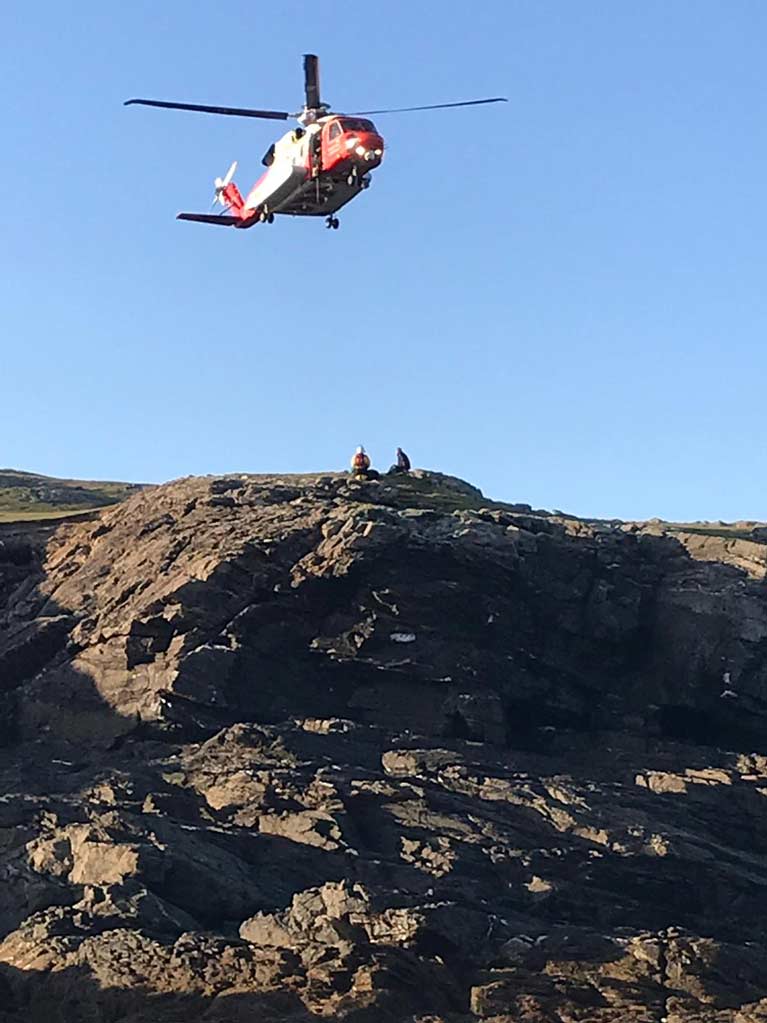 The Coastguard attend the scene
The Coastguard attend the scene
The Shannon lifeboat simultaneously provided some shelter from the southeast force 8 offshore wind and crew member Ian Shanahan was able to go ashore safely and assess the situation. The casualty appeared well but had sustained minor injuries during the ordeal so the Rescue 118 helicopter winched them both from the island and the casualty was transferred to Castlebar General Hospital. The severity of the weather meant that the yacht could not be recovered safely.
Both lifeboats returned to station at 7.20 pm and Coxswain James Mullen said “This callout was a very serious situation for a lone sailor whose equipment had failed and luckily he was able to raise the alarm by mobile phone. It really put into practice all of our combined training and seamanship skills and the rapid response times of both boats was remarkable. This was the first callout with the new Shannon Class lifeboat fully involved and it was great to be able to work together so well and effectively”.
See video of this rescue here
Five people were rescued off North Co Antrim yesterday afternoon (Friday 30 August) when their 33ft yacht got into difficulty near Rathlin Island.
Red Bay RNLI’s volunteer crew were requested to launch their all-weather lifeboat 1.20pm following a report that the yacht was struggling to make headway in difficult conditions at sea some five miles south-east of Rathlin.
Two of the crew onboard the yacht — which was on passage to Carrickfergus — were also suffering from seasickness, Red Bay RNLI says.
The lifeboat crew set up a tow and brought the vessel to Ballycastle. Speaking later, Red Bay RNLI press officer Paddy McLaughlin said: “Conditions at sea were challenging this afternoon and the crew made the right decision to call for help.”
Elsewhere, Clifden RNLI in Connemara launched its new all-weather lifeboat for the first time on Thursday afternoon (29 August) to reports of a RIB adrift and in danger in Ballinakill Bay between Letterfrack and Renvyle.
However, it was the D class inshore lifeboat Celia Mary which was first on the scene — where volunteers found two people on a 5.5m RIB with engine failure that was very close to the rocky shore in worsening weather conditions, with a Force 6 wind at the time.
Lifeboat helm Thomas Davis agreed with the two people on board the RIB that the vest course of action was a tow back to shore, which was safely completed.
Davis said: “We were glad to be able to help these people recover their boat today.
“We also wish to remind all water users in Connemara to contact the coastguard or emergency services at the earliest opportunity when things go wrong — we would always rather launch and be stood down than risk other possible outcomes.”
Sea Kayakers Rescued By Clifden Lifeboat Crew
Two sea kayakers were rescued from the water off Ballyconneely in western Connemara by Clifden RNLI’s volunteer lifeboat crew yesterday afternoon (Tuesday 6 August).
Just after 4.30pm the lifeboat station’s volunteers responded to reports via the Irish Coast Guard of kayakers in distress from a member of the public on shore, who gave detailed information of their location.
According to Clifden RNLI, the lifeboat crew were told one kayaker had entered the water and got into difficulty when they were separated from the vessel, which had also flooded and capsized.
Clifden’s Atlantic 85 inshore lifeboat, helmed by Joe Acton, was first on the scene and found the two kayakers standing and waving from offshore rocks near the Connemara Golf Course.
The two women, with their the remaining kayak, were taken on board the lifeboat where they were quickly assessed and given blankets as they were returned to shore, where members of Cleggan Coastguard Unit took over their care.
Clifden’s inshore D class lifeboat was also on the scene having travelled by road and launched at a nearby beach. Helmed by Owen Hayes, this second lifeboat recovered the capsized kayak and also returned to shore.
The Mersey class all-weather lifeboat was stood down en route to the scene.
This was the third launch in a week by the Clifden lifeboat crew. The station’s operations manager John Brittain said: “The crew did very well today to get three boats on the water in a matter of minutes and thankfully we were on the scene very quickly.
“This is an example of how situations at sea can change rapidly, and the vigilance of the public is so important, especially at busy times of year and in holiday destinations.”
RNLI Clifden Welcomes its First Shannon-Class Lifeboat
North Connemara’s Clifden has become the first west coast RNLI station to receive a new Shannon-class lifeboat writes Lorna Siggins.
The all-weather Shannon, which was designed by an Irish engineer and is the first RNLI class to be named after an Irish river, was given a warm welcome by several hundred people at Clifden Quay yesterday.
Named the Brianne Aldington, the 13-metre Shannon reduces response times to call-outs, as it has a top speed of 25-knots. It replaces the Mersey-class 15 knot vessel at Clifden and represents a 2.4 million euro investment by the RNLI in the west coast.
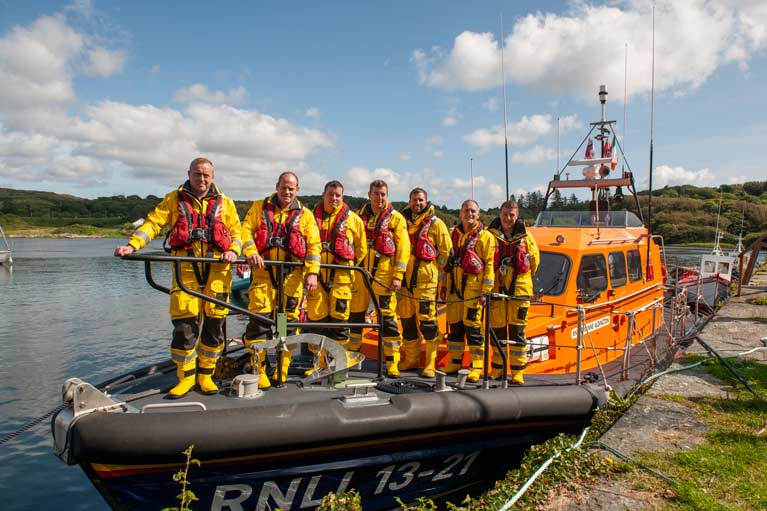
The Shannon was designed by Derry man Peter Eyre who as a child was rescued by Lough Swilly RNLI in Donegal. It has a maximum speed of 25 knots and an endurance of 250 nautical miles.
It is propelled by waterjets, rather than propellers, and it can be driven directly onto a beach for recovery.
The vessel can be recovered directly from the beach by her launch and recovery tractor. Once winched up from the beach, the tractor’s carriage revolves 180 degrees so that the lifeboat is repositioned for relaunching.
The 24-person voluntary crew at Clifden includes a husband and wife and a father and son, while two of its four coxswains are brothers.
Clifden RNLI coxswain James Mullen recalled yesterday how the station received its first all-weather craft three years ago and was thrilled then.
“ However, with the arrival of the Shannon, we have 21st-century lifeboat design and technology. Bringing her home to Clifden from Poole was one of my proudest moments. As we rounded Loop Head we hit a bit of weather and we really made her dance,” he said.
“ The ergonomic seats bear the force of the impact of the lifeboat hitting the waves, and the improved communications technology means the crew can talk to each other by linked headsets and can hear each other above the noise and receive information directly from the Coast Guard,” Mr Mullen said.
The Clifden crew have trained intensively since May and will consolidate this off the Connemara coast before the Shannon is declared on service and the Mersey is retired. The former lifeboat will be sold on to a charity.
The RNLI says the first planned outing for the new lifeboat is to visit the nearby island communities on Inishbofin and Inishturk.
The new vessel left RNLI headquarters in Poole for Clifden on July 24th for its delivery run across the Irish Sea, crewed by two coxswains, David Barry and Alan Pryce, two mechanics, Thomas Davis and Andrew Bell and navigator Owen Hayes.
There are currently two Shannon-class lifeboats at Lough Swilly in Donegal and Clogherhead, Co Louth, and a relief vessel at the Wicklow station.
Clogherhead received its Shannon-class in early June. The vessel was funded through a generous legacy by a Wexford farmer, Mr Henry Tomkins, who was a lifelong supporter of the RNLI. Mr Tomkins stipulated that a lifeboat be named after former Arklow RNLI coxswain Michael O’Brien, his lifelong friend.




























